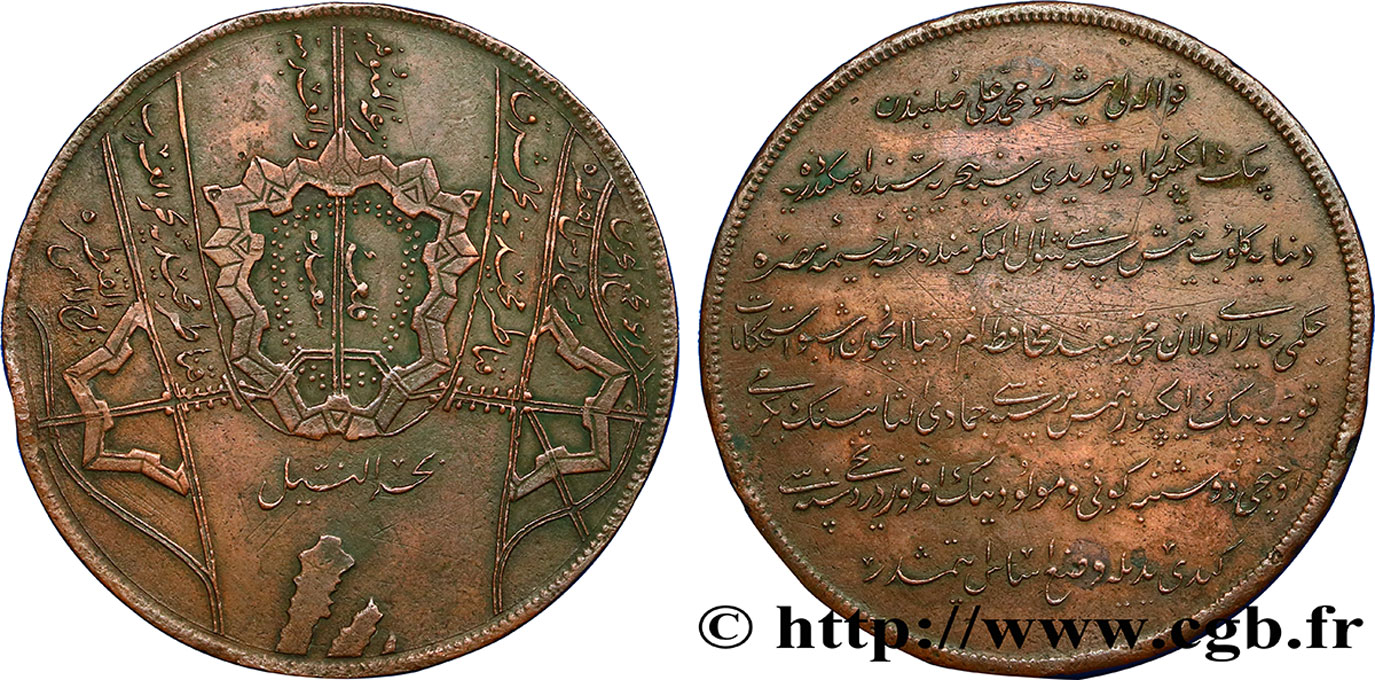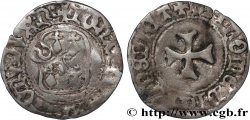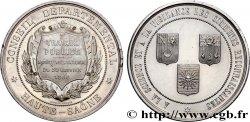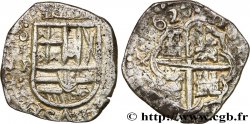Live auction - fme_401215 - ÉGYPTE - ROYAUME D'ÉGYPTE - ABDUL MEJID Médaille pour Abdul-Medjid et Saïd Pacha
得先注册又得到批准才可以报价。为了报价注册. 客户应该得到公司允许,那种过程需要 48 个小时。别等出售结束那一天才登记。您报价的话等于您赞成买那物品,而且按« 保价 » 证明您接受 cgb.fr 因特网拍卖使用法.
报价时只可以出全数值欧元总额。物品描述也说明销售结束时间,结束后出价都不会生效。 报价命令转达有时变动,等到最后秒钟增加否决的可能会。想多了解的话请注意 因特网拍卖常问
最高出价方将支付18%的不含税的拍卖费用
最高出价方将支付18%的不含税的拍卖费用
| 估算 : | 900 € |
| 价格 : | 没有出价 |
| 最高出价 : | 没有出价 |
| 拍卖结束日期 : | 31 October 2017 17:32:34 |
种类 Médaille pour Abdul-Medjid et Saïd Pacha
日期: 1855
铸币厂名称/城市 Égypte, Turquie
材质 bronze
直径 63 mm
模子方针 12 h.
重量 91 g.
侧面 lisse
稀少度 R2
关于品相的说明
Intéressante médaille avec de beaux reliefs. Patine brune avec une usure homogène et quelques coups sur la tranche
正面
正面的文字 LÉGENDE ARABE.
正面的说明书 Plan de fortification sur le Nil ; carte géographique avec légendes en arabe.
背面
背面的文字 LÉGENDE ARABE.
背面的说明书 Légende en 7 lignes hrizontales.
评论
Un exemplaire de cette rare médaille a été vendu 820$ en 2008 par Gorny & Mosch et un autre à 884$ en 2009 par Meister & Sonntag. En argent, bien que très usé, un exemplaire a été vendu 1900€ par H. D. Rauch en 2012 et revendu par Palombo 2700 francs suisses. Et plus récemment en 2017, Kunker a vendu un exemplaire à 3000€ (Auction 289, n° 2056).
Pour cette médaille, voir l’article "The Barrage Fortress Medal 1855 of Egyptian Vice-Roy Muhamad Sa'id Pasha" par K. M. MacKenzie dans le Bulletin 39/40 de la Société numismatique turque, Istanbul 2003, S. 97-99.
Abdülmecid Ier (Abdul-Medjid) fils ainé de Mahmoud II succède à l'âge de seize ans à son père, au moment où Ibrahim Pacha marchait sur Istanbul, et ne dut qu'à l'intervention européenne le maintien de l'intégrité de son empire (traités du 15 juillet 1840 et du 13 juillet 1841). Il poursuit, mais sans violence, les réformes commencées par son père et accorde à tous ses sujets, sans distinction de religion, par le hatti-chérif de Gulhané (3 novembre 1839) et le hatti-houmaioum du 11 février 1856, des garanties pour leur vie, leur fortune et leur liberté, et crée le conseil du tanzimat, chargé d'appliquer et d'étendre ces réformes.
Il fait réprimer de nombreuses insurrections, notamment celle de Bedirxan Beg au Kurdistan (1841-1847) ; il refuse en 1853 de céder au prince Menchikov au sujet de la protection par la Russie des lieux saints et des sujets grecs de l'empire ottoman, et soutient, avec l'appui de la France et de l'Angleterre, la Guerre de Crimée contre la Russie, qui se termine par le traité de Paris (1856).
Saïd Pacha (1822 - 1863) est le gouverneur (al-wālī) d’Égypte et du Soudan de 1854 à 1863. Il est le quatrième fils de Méhémet Ali. Muhammad Saïd, instruit à Paris, est francophone. Il succède à Abbas Ier après la mort de celui-ci en 1854 et hérite du titre de pacha que s'était octroyé son père.
Durant la Guerre civile américaine, qui entraine une pénurie de coton, l’Égypte devient le principal fournisseur des industries textiles européennes.
À la demande de Napoléon III en 1863, un bataillon de soldats soudanais part se battre au Mexique contre la rébellion des indépendantistes mexicains.
Sous le règne de Saïd, l’influence des cheikhs diminue.
Saïd est également à l'origine de la création du Service de conservation des antiquités de l'Égypte en 1858 (en même temps que du musée de Boulaq, qui est un organe indissociable du Service). Il en confia la direction à Auguste Mariette..
A example of this rare medal was sold for $820 in 2008 by Gorny & Mosch and another for $884 in 2009 by Meister & Sonntag. In silver, although very worn, a example was sold for €1,900 by H. D. Rauch in 2012 and resold by Palombo for 2700 Swiss francs. And more recently in 2017, Kunker sold a example for €3,000 (Auction 289, no. 2056).
For this medal, see the article \\\"The Barrage Fortress Medal 1855 of Egyptian Vice-Roy Muhamad Sa'id Pasha\\\" by K. M. MacKenzie in Bulletin 39/40 of the Turkish Numismatic Society, Istanbul 2003, S. 97-99.
Abdülmecid I (Abdul-Medjid), eldest son of Mahmoud II, succeeded his father at the age of sixteen, at the time when Ibrahim Pasha was marching on Istanbul, and owed only to European intervention the maintenance of the integrity of his empire (treaties of July 15, 1840 and July 13, 1841). He continued, but without violence, the reforms started by his father and granted to all his subjects, without distinction of religion, by the hatti-sherif of Gulhané (November 3, 1839) and the hatti-houmaioum of February 11, 1856, guarantees for their life, their fortune and their freedom, and created the council of the tanzimat, responsible for applying and extending these reforms..
He suppressed numerous insurrections, notably that of Bedirxan Beg in Kurdistan (1841-1847); in 1853 he refused to give in to Prince Menshikov on the subject of Russian protection of holy places and Greek subjects of the Ottoman Empire, and supported, with the support of France and England, the Crimean War against Russia, which ended with the Treaty of Paris (1856)..
Said Pasha (1822 - 1863) was the governor (al-wālī) of Egypt and Sudan from 1854 to 1863. He is the fourth son of Mehemet Ali. Muhammad Said, educated in Paris, is French-speaking. He succeeded Abbas I after his death in 1854 and inherited the title of pasha that his father had given himself..
During the American Civil War, which led to a cotton shortage, Egypt became the main supplier to the European textile industries..
At the request of Napoleon III in 1863, a battalion of Sudanese soldiers left to fight in Mexico against the rebellion of Mexican independence fighters..
Under Said's reign, the influence of the sheikhs diminished..
Said was also responsible for the creation of the Egyptian Antiquities Conservation Service in 1858 (at the same time as the Boulaq Museum, which is an inseparable organ of the Service). He entrusted its management to Auguste Mariette.
Pour cette médaille, voir l’article "The Barrage Fortress Medal 1855 of Egyptian Vice-Roy Muhamad Sa'id Pasha" par K. M. MacKenzie dans le Bulletin 39/40 de la Société numismatique turque, Istanbul 2003, S. 97-99.
Abdülmecid Ier (Abdul-Medjid) fils ainé de Mahmoud II succède à l'âge de seize ans à son père, au moment où Ibrahim Pacha marchait sur Istanbul, et ne dut qu'à l'intervention européenne le maintien de l'intégrité de son empire (traités du 15 juillet 1840 et du 13 juillet 1841). Il poursuit, mais sans violence, les réformes commencées par son père et accorde à tous ses sujets, sans distinction de religion, par le hatti-chérif de Gulhané (3 novembre 1839) et le hatti-houmaioum du 11 février 1856, des garanties pour leur vie, leur fortune et leur liberté, et crée le conseil du tanzimat, chargé d'appliquer et d'étendre ces réformes.
Il fait réprimer de nombreuses insurrections, notamment celle de Bedirxan Beg au Kurdistan (1841-1847) ; il refuse en 1853 de céder au prince Menchikov au sujet de la protection par la Russie des lieux saints et des sujets grecs de l'empire ottoman, et soutient, avec l'appui de la France et de l'Angleterre, la Guerre de Crimée contre la Russie, qui se termine par le traité de Paris (1856).
Saïd Pacha (1822 - 1863) est le gouverneur (al-wālī) d’Égypte et du Soudan de 1854 à 1863. Il est le quatrième fils de Méhémet Ali. Muhammad Saïd, instruit à Paris, est francophone. Il succède à Abbas Ier après la mort de celui-ci en 1854 et hérite du titre de pacha que s'était octroyé son père.
Durant la Guerre civile américaine, qui entraine une pénurie de coton, l’Égypte devient le principal fournisseur des industries textiles européennes.
À la demande de Napoléon III en 1863, un bataillon de soldats soudanais part se battre au Mexique contre la rébellion des indépendantistes mexicains.
Sous le règne de Saïd, l’influence des cheikhs diminue.
Saïd est également à l'origine de la création du Service de conservation des antiquités de l'Égypte en 1858 (en même temps que du musée de Boulaq, qui est un organe indissociable du Service). Il en confia la direction à Auguste Mariette..
A example of this rare medal was sold for $820 in 2008 by Gorny & Mosch and another for $884 in 2009 by Meister & Sonntag. In silver, although very worn, a example was sold for €1,900 by H. D. Rauch in 2012 and resold by Palombo for 2700 Swiss francs. And more recently in 2017, Kunker sold a example for €3,000 (Auction 289, no. 2056).
For this medal, see the article \\\"The Barrage Fortress Medal 1855 of Egyptian Vice-Roy Muhamad Sa'id Pasha\\\" by K. M. MacKenzie in Bulletin 39/40 of the Turkish Numismatic Society, Istanbul 2003, S. 97-99.
Abdülmecid I (Abdul-Medjid), eldest son of Mahmoud II, succeeded his father at the age of sixteen, at the time when Ibrahim Pasha was marching on Istanbul, and owed only to European intervention the maintenance of the integrity of his empire (treaties of July 15, 1840 and July 13, 1841). He continued, but without violence, the reforms started by his father and granted to all his subjects, without distinction of religion, by the hatti-sherif of Gulhané (November 3, 1839) and the hatti-houmaioum of February 11, 1856, guarantees for their life, their fortune and their freedom, and created the council of the tanzimat, responsible for applying and extending these reforms..
He suppressed numerous insurrections, notably that of Bedirxan Beg in Kurdistan (1841-1847); in 1853 he refused to give in to Prince Menshikov on the subject of Russian protection of holy places and Greek subjects of the Ottoman Empire, and supported, with the support of France and England, the Crimean War against Russia, which ended with the Treaty of Paris (1856)..
Said Pasha (1822 - 1863) was the governor (al-wālī) of Egypt and Sudan from 1854 to 1863. He is the fourth son of Mehemet Ali. Muhammad Said, educated in Paris, is French-speaking. He succeeded Abbas I after his death in 1854 and inherited the title of pasha that his father had given himself..
During the American Civil War, which led to a cotton shortage, Egypt became the main supplier to the European textile industries..
At the request of Napoleon III in 1863, a battalion of Sudanese soldiers left to fight in Mexico against the rebellion of Mexican independence fighters..
Under Said's reign, the influence of the sheikhs diminished..
Said was also responsible for the creation of the Egyptian Antiquities Conservation Service in 1858 (at the same time as the Boulaq Museum, which is an inseparable organ of the Service). He entrusted its management to Auguste Mariette.








 对产品描述纠错
对产品描述纠错 打印
打印 分享我的选择
分享我的选择 提问
提问 Consign / sell
Consign / sell










